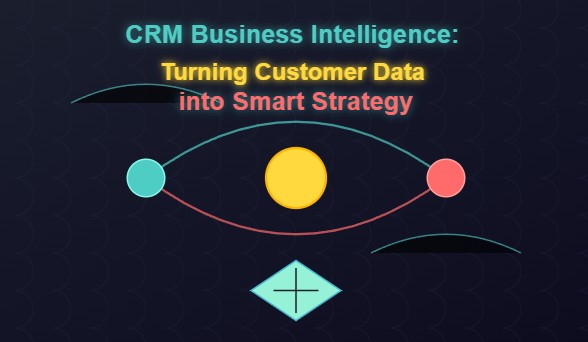In today’s hyper-competitive digital economy, the edge doesn’t go to the loudest brand—but to the smartest. Businesses that thrive aren’t just those collecting customer data; they are the ones translating it into actionable intelligence. Welcome to the world of CRM Business Intelligence—where customer relationships meet data science, and insights fuel decisions across sales, marketing, service, and strategy.
This article explores the powerful intersection of CRM (Customer Relationship Management) systems and Business Intelligence (BI). It breaks down what CRM Business Intelligence means, how it works, and why it’s becoming a non-negotiable asset for organizations that want to scale intelligently.
Table of Contents
🧠 What is CRM Business Intelligence?
CRM Business Intelligence refers to the tools, processes, and technologies used to analyze customer-related data collected through CRM systems to extract insights, visualize trends, and inform strategic decisions.
Think of it as a real-time feedback loop between customer behavior and business action:
-
CRM captures the data → BI analyzes the data → Insights drive decisions → Decisions influence customers → And the loop repeats.
This transforms a CRM from a data repository into a strategic decision engine.
🔍 The Need for Business Intelligence in CRM
CRM systems on their own do an excellent job of managing relationships—but without analytical tools, it’s like flying a jet without a dashboard.
Here’s why CRM Business Intelligence is mission-critical:
✅ Real-Time Insights
Track what’s happening now—sales funnels, customer service KPIs, campaign performance—so teams can respond faster.
✅ Forecasting and Predictive Modeling
BI tools can project future outcomes like churn risk, revenue growth, or lead conversion potential using historical CRM data.
✅ Performance Measurement
Know which sales reps are closing the most deals, which channels bring in the best leads, and which customers are most valuable.
✅ Data-Driven Culture
BI dashboards make customer data accessible across departments, aligning decisions with customer behavior, not guesswork.
🧩 Key Components of CRM Business Intelligence
To fully leverage CRM BI, you need a robust stack of components working together:
1. Data Collection (CRM Core)
Your CRM system (like Salesforce, HubSpot, Zoho, or Dynamics 365) gathers:
-
Lead & contact data
-
Opportunity status
-
Interactions (calls, emails, meetings)
-
Campaign engagement
-
Purchase and support history
2. Data Warehouse / Central Repository
Raw CRM data flows into a central BI environment (e.g., Microsoft Azure, AWS Redshift, Google BigQuery) where it can be cleaned, joined, and queried at scale.
3. BI Platform
Business Intelligence tools like Power BI, Tableau, Looker, or Qlik are used to visualize and analyze the data.
4. Analytics & Machine Learning Models
These models use CRM data to uncover deeper patterns:
-
Lead scoring predictions
-
Customer segmentation
-
Upsell opportunities
-
Churn risk flags
5. Dashboards & Reports
Custom, interactive dashboards present KPIs to each department:
-
Sales pipeline health
-
Customer lifetime value (CLV)
-
Email campaign conversions
-
Support ticket resolution times
📊 CRM BI Use Cases Across Business Units
🛒 Sales Intelligence
-
Forecast sales revenue with predictive analytics
-
Identify bottlenecks in the sales pipeline
-
Optimize rep performance with activity analysis
-
Score leads based on behavior and demographics
📣 Marketing Intelligence
-
Track multi-channel campaign ROI
-
Segment customers based on past behavior
-
Identify top-performing content or offers
-
Create personalized journeys from data clusters
🎧 Customer Service Intelligence
-
Measure resolution time and satisfaction (CSAT)
-
Predict service volume and allocate agents accordingly
-
Track repeat issue trends and self-service adoption
-
Identify common complaint triggers
🧾 Finance & C-Suite
-
Calculate cost of acquisition vs. customer lifetime value
-
Align budget with high-yield campaigns or territories
-
See how operational metrics affect bottom-line revenue
-
Enable real-time boardroom-level dashboards
💡 Strategic Benefits of CRM Business Intelligence
CRM BI is more than data—it’s business enablement. Here’s how it transforms strategy:
1. Smarter Decision-Making
Executives get real-time, data-backed clarity—no gut instinct needed.
2. Proactive Customer Management
Predict and prevent churn, upsell at the right moment, and guide customers based on actual behavior.
3. Operational Efficiency
See which processes waste time and resources—then optimize them based on measurable KPIs.
4. Cross-Team Alignment
Everyone from sales to service is working off the same truth: live, shared customer intelligence.
🛠️ Leading Tools for CRM Business Intelligence
1. Microsoft Power BI + Dynamics 365
-
Native connector to Dynamics CRM
-
Highly customizable dashboards
-
Scalable for large organizations
2. Salesforce Einstein Analytics
-
AI-powered analytics inside Salesforce
-
Predictive lead scoring, opportunity insights
-
Real-time opportunity risk assessment
3. Zoho Analytics
-
Pre-built CRM reports
-
Easy drag-and-drop interface
-
Affordable for small businesses
4. HubSpot Custom Reports
-
Strong on marketing attribution
-
Integrates across HubSpot CRM suite
-
Simple UI, ideal for non-analysts
5. Tableau
-
Advanced data modeling and visuals
-
Integrates with almost any CRM (Salesforce, HubSpot, Zoho, etc.)
-
Great for BI teams and power users
🧠 Challenges in Implementing CRM Business Intelligence
It’s not all plug-and-play. Real CRM BI requires planning.
❌ Data Silos
Data might be trapped in disconnected systems—CRM, email, ERP—which makes unified analytics tough.
Solution: Use APIs or data integration platforms (like Zapier, MuleSoft, or Azure Data Factory).
❌ Dirty Data
CRM data can be outdated, inconsistent, or incomplete.
Solution: Implement data validation rules, periodic cleansing, and user training.
❌ Lack of Strategy
Having dashboards doesn’t mean people know how to use them.
Solution: Align BI outputs to business objectives and provide training.
❌ Real-Time Sync Delays
Some CRMs don’t update BI dashboards in real-time.
Solution: Use live connections or high-frequency sync jobs with cache strategies.
🚀 Future of CRM Business Intelligence
CRM BI is evolving fast. Expect innovations like:
-
Real-Time Prescriptive Analytics: BI not only predicts but tells you what to do.
-
Embedded BI in CRM UI: Insights where users work—not in separate dashboards.
-
Voice-Powered Analytics: Ask your BI assistant, “How are my leads converting in Europe?”
-
Behavioral Analytics: Use AI to detect intent, interest, or hesitation based on user actions.
-
No-Code AI Modeling: Let marketers build their own churn models without data scientists.
🧠 Final Thoughts: From CRM to Smart CRM
Customer data is the new gold, but raw data isn’t valuable unless refined. CRM Business Intelligence is that refinery—extracting insights, shaping strategies, and fueling growth.
In a market driven by intelligence, CRM BI is not just a feature—it’s a foundation.
By integrating Business Intelligence into your CRM ecosystem, you transform from reactive to proactive, from transactional to strategic, and from data-rich to insight-rich.




